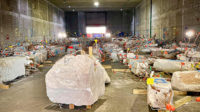Federal investigators looking into the causes of the partial collapse of the 40-year-old Champlain Towers South residential condominium in Surfside, Fla., last year have developed about two-dozen hypotheses, and are working to prove or disprove each, using a growing collection of evidence. They aim to issue recommendations for changes to building codes and standards, in an effort to avoid a similar tragedy, by the end of 2024.
Members of the investigation team from the U.S. Dept. of Commerce’s National institute of Standards and Technology gave an update on their progress June 9 during a National Construction Safety Team Advisory Committee meeting. Glenn Bell, the associate lead investigator, said it is a difficult, complex investigation that, even almost a year after the June 24 collapse that killed 98, has not identified a clear initiating event.
None of the hypotheses have been ruled out yet, Bell said. And while some of the potential factors have been publicly highlighted, other scenarios have not yet been shared. It is likely several factors contributed to the collapse, he added.
“To determine how and why the failure occurred, we can leave no stone unturned,” Bell said. “We have to thoroughly investigate each possibility.”
Investigators have two main strategies for testing each hypothesis: progressive collapse analysis and collapse evidence analysis, Bell said. The former uses tools, such as computer simulations, to determine an initiating point of failure and how it spread through the structure. The latter considers nonquantitative evidence such as videos of the collapse, photos of damage and specimens taken from the debris pile that can help reveal the collapse scenario.
As ENR previously reported, NIST has broken the investigation into six projects to examine different aspects of the case, including building and code history, evidence collection and preservation, materials science, geotechnical engineering and structural engineering, plus remote sensing and data visualization added last fall. In addition to NIST’s professionals, the team includes outside experts from universities and the U.S. Army Corps of Engineers.
While the investigation is ongoing, a Miami-Dade Circuit Court judge approved a $1.02-billion settlement for the victims' families June 23. And $96 million from the sale of the property will be split among those who owned units in the building.
Developing Recommendations
Judith Mitrani-Reiser, the lead investigator, said the investigation will lead to recommendations for codes and standards to try to prevent a similar collapse from happening. And because there are many similar buildings, the team will likely be including recommendations for existing buildings, she added.
“Nearly a year after this terrible collapse, our dedication is stronger than ever to get to the bottom of what caused Champlain Towers South to collapse so that a tragedy like this never happens again,” Mitrani-Reiser said.
While the NIST team has gathered its own materials—including more than 600 physical specimens from the collapse pile plus any documents about the building, photos from the collapse and its aftermath and interviews with anyone with firsthand experience with the building or collapse—the investigators are also asking anyone with related data to share it. NIST has a data portal on its website where photos, video and other documentation can be submitted.
NIST probers are using their various analyses to create a detailed timeline of the minutes before, during and after the collapse, Bell said. They are also developing 3D models, and plan to create animations demonstrating their eventual findings.





